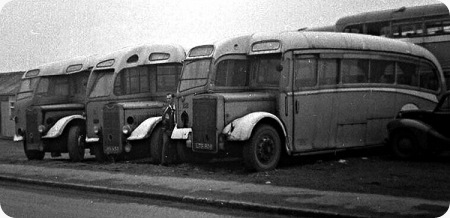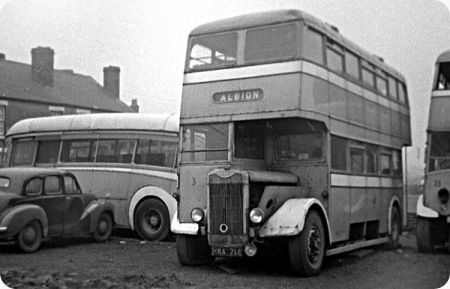
Copyright Ray Soper
Harper Bros
1943
Guy Arab I
Park Royal H56R rebodied Northern Coachbuilders 1954
This shot is from the Ray Soper gallery contribution titled ‘Harper Brothers of Heath
Hayes’ click on the title if you would like to view his Gallery and comments to it.
The shot
is shown here for indexing purposes but please feel free to make any comment regarding this vehicle
either here or on the gallery.
19/05/12 - 16:40
I would like to know exactly where in Heath Hayes the Harper Brothers garage
was if anyone knows it would be much appreciated.
Rod
20/05/12 - 07:36
Don’t know about the depot, but the bus was new to Sheffield in 1943, gone by
1949. It was a solo vehicle.
Les Dickinson
20/05/12 - 07:37
I remember Harpers Bros Buses and Coaches very well in my childhood days as
they used to go past my old house in Erdington Road, Aldridge and after I left Aldridge with my
parents and sister on Saturday 10th June 1961 to move to Lichfield. As me and my parents and sister
used to use them to visit our Aunty and Uncle who used to live in Daniels Lane, off Erdington Road,
Aldridge
Andrew Holder
20/05/12 - 09:09
Looking at the Gallery, the poor buses look rather battered and neglected so
due for the scrapyard yet are not that old so maybe Harpers were not exactly good on maintenance.
It’s a shame that these quite characterful vehicles did not have a better life let alone
survive.
Richard Leaman
22/05/12 - 14:46
Hi Rod the garage lay between the Cannock Rd and the Hednesford Rd Heath Hayes
approx 100yards from the 5 ways island, other than the 1st photo that was taken inside the garage
the other photos were taken on ground opposite the rear of the garage on the Cannock Rd prior to
Newlands Lane. I think part of the premises are now a tyre depot. They also had a garage on the
Stafford Rd Cannock that housed I think 2 Vehicles, a workshop at High Green Cannock where Fleet 14
in Photo at rear of Heath Hayes Garage was re bodied and a Garage that housed a couple of coaches at
Aldridge opposite Portland Rd (town end).
Hi Richard you are right in thinking some of the
buses looked neglected in the photo that’s because they were indeed scrap except for Fleet 31 in the
middle of the three half cabs, they were old and had come to the end of there safe working
serviceable life. The vehicles that were in service were in fact very well maintained.
Phil Burton
26/05/12 - 20:38
Many thanks Phil. I had a hunch it was down that road somewhere. My partner
says that sounds about right think there are flats there now.
Rod
12/06/12 - 07:30
Heath Hayes has a Walsall post code. Could the Guy’s odd destination refer to
West Bromwich Albion football ground, "The Hawthorns"?
Pete Davies
12/06/12 - 11:42
Hi Pete. You are indeed right, the destination did in fact mean West Bromwich
Albion. Harpers ran football excursion buses to all the local teams on Saturdays and any night
matches. The destinations would be Albion, Villa, Wolves etc. If the Team wasn’t on the destination
blind, Football would be put up and a painted or chalked destination board would be displayed in the
drivers window or in a purpose made destination board holder.
Phil Burton
13/06/12 - 09:44
Did this bus have a replacement utility body whilst in Sheffield service?
Quoted as rebodied by NCB, and obviously not a Park Royal, this would seem to be quite an unusual,
and interesting occurrence. If so, where did the NCB utility body come from?
John Whitaker
21/09/12 - 06:58
I have never lived in the West Midlands, so my first-hand experience of
Harpers is restricted to a visit to the depot and a ride on a what was then a relatively new Daimler
Fleetline on their service from Cannock (via a rather roundabout route) into Birmingham. From these
experiences, and from general comments in the enthusiast press, I would say that Harpers were
considered one of the leading operators of the day - much better thought of than not only other
independents, but many NBC subsidiaries, PTEs, and larger municipalities. The fact that a proportion
of the fleet was secondhand did nothing to detract from the fleet’s overall presentation, they
always bought quality vehicles and looked after them.
David Call
22/09/12 - 07:05
I think David Call is absolutely right. I visited the depot once and it seemed
to me at the time like a very well run company both operationally and maintenance wise. I remember
that on the day I went, one of the Royal Tigers with Harpers own bodywork was receiving attention in
the depot. I also went on a ‘Farewell to Harpers’ tour when it was known that they were
selling out to Midland Red. On that occasion I had the interesting experience of travelling on 888
DUK, the Guy Arab V with the odd looking Strachans body. I believe that by then it had a Leyland
0600 engine.
It was actually a very sad loss when they closed, a substantial operator which
had been well respected. I would admit that their unusual livery perhaps didn’t suit every vehicle,
but it was certainly distinctive!
Chris Barker
23/09/12 - 06:32
Contemplate, chaps. It seems that Harper’s and Ledgard’s were soul mates. Are
there any other mixed operators like this that the rest of you out there would like to nominate?
Pennine? Who else?
David Oldfield
24/09/12 - 07:22
Indeed there are David, I’ve always thought the obvious pair were South
Yorkshire and South Notts. So many similarities, it’s almost uncanny. To name a few; both had
similar size fleets, both operated busy inter-urban services, both had a blue livery, both were
mainly stage service operators but with a modest coaching side too, all of their double deckers were
lowbridge or low height, all vehicles were bought in two’s or three’s, both bought all-Leyland
PD2’s, then turned to other bodybuilders for PD2’s and PD3’s, both had Atlantean PDR1/3’s with
Northern Counties bodies, both later turned to the Fleetline with Leyland engine, again with NCME
bodies, both ended with the Olympian. I’m sure there were other similarities but you get my
drift!
Chris Barker
15/11/12 - 11:15
I heard a guy was writing a book about Harper Bros. Anyone know if it has been
completed?
Rod
15/11/12 - 15:02
The book is ‘Harpers Bus Memories in Colour’, published by Irwell Press,
which was due to be available in October 2012 price £12.95. It is listed in the latest MDS Books
catalogue, reference IR956.
John Stringer
15/11/12 - 15:53
Paul Roberts book ‘Harpers Bus Memories in Colour’ is still
awaited.
Philip Lamb
23/11/12 - 08:19
The book is now on the shelf for purchase.
Phil Burton
06/12/12 - 06:55
There is also another long awaited book being written, this is a far more in
depth publication. This one will trace the actual history from day one. I would imagine it is not
far away now. I will try and get in touch with the author.
Mick Bullock
21/02/13 - 17:38
The Northern Coachworks Body put on Guy Arab I HWA 714 Fleet No 3 in 1954 was
a Lowbridge L27/26R. It finished service December 1963.
Phil Burton
18/10/13 - 07:38
In addition to local football trips, Harpers ran to important away matches too
- I remember going to watch Wolves in a cup match at Leeds with my grandmother some time in the 70s.
Used to catch Harpers buses between Shire Oak and Brownhills, then Walsall Corporation on to Pipe
Hill where footballing grandmother lived (non-footballing one at Shire Oak made a convenient stop
off on Sunday when the less frequent services left me to wait in the rain ….)
ex ENOC conductor
22/03/14 - 17:15
In the fifties I grew up as neighbour to Felix Harper and to his neighbour
sister Mary Harper in the large houses (286 to 280 Cannock rd) that they had built in the thirties.
There was a large field next to our houses which gave access to another large field which lay behind
our three houses. This was the hidden junkyard for all the old Harpers buses where a handful of
those of us kids ‘in the know’ spent many a happy, forbidden and dangerous hour playing and
trespassing.
Sheila James Baggaley
20/09/14 - 06:00
Harpers had a small garage at Aldridge as well along from the Avion cinema. My
Dad Jack Preston was the Coop chemist in the same road. Anchor Road. From 1957 until 1965 used to go
to school in Lichfield every day on a Harpers bus. In 1958 I had an accident coming home when I fell
off one of the single deckers with a sliding door at the front and the back wheel of the bus went
over the bottom of my leg. Still limping today. Good old Gloria deluxe.
Bryan Preston
08/10/15 - 14:54
It’s sometime since I made a comment on this post has I didn’t have much more
to add, however, I don’t remember inspectors being on Harper’s buses, have I got this right?
Jimmie
06/01/16 - 05:37
No Jimmie, Harold Haytree was the inspector, and also at one stage Bob Finch
who was ex police joined the company.
Phil Burton
12/01/16 - 14:07
In my student days, back in 1966, I worked with the company as a conductor for
about eight weeks in July / August.
Harold Haytree was the Inspector - but his duties didn’t
involve any actual inspecting! He was the firm’s ‘presence’ at Cannock Bus Station, and I
think he may have had a hand in compiling duty rotas.
The fleet comprised mainly ex London
Transport type RT double deckers. I recall the purchase and arrival of a replacement for a
crash-damaged vehicle - and the scramble for a trophy in the form of the London Transport radiator
badge (replaced by a standard AEC radiator badge).
My other memory was the uniform - emerald
green double-breasted dust jackets with cream facings. Very distinctive! Only, they only had one in
stock when I joined: it was much MUCH too big!
Having conducted for Liverpool Corporation
Passenger Transport the previous summer, I was used to having my own ticket machine (an
‘Ultimate’). At HB, we took any available ‘Setright’ from a hook in the crew room!
Les
13/01/16 - 06:08
Here are a lot of photos of Harper’s vehicles, an amazing assortment which,
had they survived, would have made a wonderful museum collection. They had a fair selection of
London Transport RT/RTL’s, too. SEE: //www.heathhayeshistory.co.uk/harpers_buses_1/
Chris Hebbron
14/01/16 - 06:02
Thanks for that link to the Harper fleet, Chris- a fascinating array, even
though some of the captions are a bit doubtful (e.g. Cravens RT body built in Anglesey). I am also
curious about the single deck Guy Arab JVK 654 with its " back to front gearbox". Did it
have one forward gear and four reverse?
Roger Cox
14/01/16 - 06:39
I think that what would be meant by a ‘back to front’ gearbox would be
that one or more gears were in a different position to what might be expected. This wasn’t at all
unusual with commercial vehicles - Bedford coaches, for instance, up to and including the VAL14 (but
not VAL70) had a so-called ‘Chinese’ gearbox.
David Call
14/01/16 - 10:03
A very common feature of Guy Arab gearboxes was that first and second gears
were against the driver’s knee, while third and fourth were nearest to the engine. We had just one
such at Ledgard’s Otley depot in the form of my beloved JUA 763. It had been new in 1943 with a
dreadful Pickering utility body, but in 1950 was rebodied in the finest tradition by Charles H Roe
its twin JUA 762 was at Armley depot from new until the end and was treated likewise at the same
time. New recruits, fresh from perhaps a lorry driving job, were often "caught out" by the
gear positions and either their errors were audibly heard for miles around or they wondered why the
bus would not pull away in top gear which they thought was second !!
Chris Youhill
14/01/16 - 16:23
Most Atkinson lorries and some ERFs had the "Chinese" gearbox.
My Tilling Stevens Coach has a 6 speed Chinese box on and i leave a diagram on the dash to
remind me
Roger Burdett
14/01/16 - 16:25
It’s the same effect as driving a LHD car- not only do you shunt your front
seat passenger into the passing traffic, thinking you are next to open space, but 1 is by your right
knee and you then move away for 3 & 4 & even 5 & 6. It don’t feel right!
Off (this) topic,
Chris- do you know how/why Wallace Arnold had a depot in Royston?
Joe
14/01/16 - 17:32
I’m fairly sure that London Transport’s later deliveries of utility Guy Arabs
had a conventional gearbox ‘gate’ and had to cut a couple of inches off the gear levers of one
type (probably the non-standard ones) to enable their drivers to distinguish between the two
types.
Chris Hebbron
15/01/16 - 06:23
Certainly most, if not all, the "reversed" gearboxes had a maroon
knob as a means of distinction - admittedly of little use in the dark !!
Chris Youhill
15/01/16 - 06:24
Yes, I did follow what the caption to the picture was getting at, but my
tongue in cheek comment about the gearbox of Guy Arab JVK 654 arose from the fact that this vehicle
was an Arab III. The wartime Arab I and earlier batches of Arab II were fitted with the old sliding
mesh gearbox with ‘right to left’ upward gear selector positions introduced with the pre war
Arab of 1934. Later production Arab IIs had a new design of constant mesh four speed gearbox with
the conventional ‘left to right’ gear lever movement. This constant mesh box was the standard
fitment to the Arab III - a few had Guy’s own preselector gearbox - so why would JVK 654 have an old
crash gearbox installed in place of its original constant mesh unit? Is the caption correct? Perhaps
confusion is arising with the Arab I double deckers KRE 849/850, about which no such comment is
made. Also, why remark upon this feature in the Guy, but fail to comment similarly about the several
Dennis Lancets in the Harper fleet. The Lancet had the Dennis ‘O’ Type gearbox, a four speed
sliding mesh unit with a preselected overdrive fifth ratio, and, again, the lever positions were
upward from right to left. When in fifth position, the gear stick was well away from the steering
column.
Roger Cox
15/01/16 - 14:38
I imagine some contributors will be able to date some of the photographs shown
in the ‘Heath Hayes Gallery’ quite accurately, given the vehicles featured. The rear shot of
two vehicles in the depot was clearly taken in Midland Red days, since the vehicle on the right is
Midland Red 2181 (XUX 417K), the Ford R192/Plaxton B47F acquired by BMMO with the business of
Hoggins, Wrockwardine Wood, in 1/74. It was apparently allocated to Heath Hayes depot from 9/74 to
7/75. The shot was presumably taken towards the beginning of that period, since the vehicle on the
left, ex-Harper’s 60 (1294 RE),Guy Arab LUF/Burlingham, was ostensibly withdrawn in 10/74. In its
brief stay with Midland Red, it would have been fleet number 2260. Did the ex-Harper vehicles not
carry MR fleetnumbers, initially? //www.heathhayeshistory.co.uk/Harpers_9_3.
David Call
15/01/16 - 15:46
The first bus I helped preserve was Burton Corporation 18 a Guy Arab 111
rebodied by Massey. It too had a Chinese box so again may have been a refit from another wartime
Arab.
Geoff S
16/01/16 - 06:02
Joe, when John Wilson was GM of NT(SE) he was directed by NBC to accept
delivery of some LHD Willowbrook Express bodied AEC Reliances for continental services: there were
more accidents with these vehicles on the continent (and, perhaps not surprisingly in the UK
[although I think they were only licensed for use between London and Dover]) than with RHD coaches -
apparently if one is used to driving an RHD vehicle it’s easier to drive one on the continent that
it is an LHD vehicle, presumably because the spatial arrangement of the controls remains the
same.
Philip Rushworth
16/01/16 - 11:36
Joe, I forgot to answer your question! Wallace Arnold’s Royston depot came
with the purchase of G E Billham in 1942 - I think Billham was largely involved with colliery
contracts. Castleford depot, acquired with M Box (Castleford) Ltd in 1946, was another depot largely
confined to contract operations (although I think some tours duties might have been operated from
Castleford depot after Gillards Tours, Normanton, was taken over in 1966. In 1969 the allocation at
Royston depot was 22 coaches; Castleford 16 coaches, including two licenced to Gillards.
Philip Rushworth
16/01/16 - 15:14
Interesting Philip. My own experience with occasional hire of LHD cars on the
continent is that I just cannot estimate the clearance from the right hand kerb from a left hand
driving seat, as I can the left hand kerb from a right hand driving seat. Accordingly I always tend
to drive much farther out into the road than necessary.
Stephen Ford
17/01/16 - 06:31
Further to John W (13/6/12) and Phil B (21/2/13), HWA 714 was apparently
acquired by Harper’s, chassis only, from Duncan of Law, then fitted with its second hand NCB body
and placed in service 4/54.
The body was reputedly new c.1949 when it was used to rebody DH
9344, a 1932 Burlingham-bodied Leyland TS3 acquired with the business of Reynolds of Cannock in
6/44. However, I have to say that the body doesn’t look 1949 vintage to me, it looks like, as John W
commented, a utility body.
They presumably made strong Leyland TS3s in 1932.
I am
inclined to suppose that Duncan of Law was ultimately superseded by Irvine’s of Law, but I’ll stand
corrected, of course. Irvine’s are still operational.
David Call
Correction - Irvine’s of Law ceased in 2012.
Adam Duncan sold out to
prolific bus company purchaser Sam Anderson, who, only a year or two later, sold on the operation to
William Irvine.
18/01/16 - 06:05
The comments about the body are most interesting. It has the look of a utility
product but there are certain aspects of it which contradict this, the drivers windscreen and the
flat front are most utility like but the side windows appear to have radiused bottom corners, the
foremost upper deck side windows have rounded corners on the front upper edge which a utility body
would not have had. The front upper deck windows have obviously been rebuilt at some point and
appear to be pan glazed. The sliding ventilators are not utility style but NCB did produce some
bodies with these on unfrozen AEC chassis earlier in the war, around 1942.
If the business of
Reynolds was acquired in 6/44 and the body was produced some time after that, there would only have
been a short period for it to be regarded as utility because I believe NCB were one of the first
bodybuilders to produce a standard post war composite design which I understand appeared in 1945.
In addition, I don’t think they built wartime bodywork in any great numbers, perhaps this was
a relaxed utility built at the very end of the war. I suppose a photograph of it when it was on the
TS3 would be too much to ask for!
Chris Barker
19/01/16 - 06:04
Thanks Philip….WA must have needed some consistent year round
trade… Could never understand how such a totally Leeds company wandered so far south. Their
fleet was always so up to date, smart and seemed of such quality, as they set off again for
Edinburgh and the Trossachs. Then came cheap flights and all the rest.
Joe
19/01/16 - 09:14
Joe, As WA grew and grew it became anything BUT a totally Leeds company, and
they had a thriving "stand alone" operation in Torquay. In view of the lovely rural roads
and lanes of Devon and Cornwall some of their brand new otherwise standard coaches were built
specially to the largely outdated 7’6" width. Then, at the other end of the UK (sorry Ms
Sturgeon), Dicksons of Dundee were taken over, bringing some superb coaches with lovely tartan
moquette seating, and a thriving customer base. Some vehicles initially operated from Leeds in
Dickson’s smart maroon livery - two lovely Reliances MYJ 764/5 are fondly recalled for
instance.
Chris Youhill
20/01/16 - 05:49
Apologies for pushing this thread further in the WA direction, but I’m hoping
Chris Youhill will be able to answer something that puzzled me for years. I can see how, with a base
in Torquay, WA’s Devon subsidiary could service a programme of extended based in the south west -
but how were the programmes based in London (ex Homeland Tours), Northamptonshire (ex United
Counties), Bristol (ex Hallens), and the ex-Dicksons Scottish-based tours serviced. And for that
after the Glasgow-Skye express service that was taken over fro Skyways? Were coaches and drivers
sent out from Leeds on rotation, or were some pick-ups "on line of route"?
Philip Rushworth
21/01/16 - 06:44
I’ve just seen the comments above about "Chinese" gearboxes. I’ve
read elsewhere that Guy’s right-to-left gearboxes had maroon gear lever knobs, but I believe this is
an error caused by the assumption that an unusual gear arrangement warranted an unusual knob. In
fact I’m pretty sure that it was the other way round - the maroon knob was introduced in 1945 to
distinguish the new constant-mesh gearbox from its Chinese predecessor. I’m sure I’ve seen some
quite late examples, and even UFs or LUFs.
I think there is also confusion over Bedfords.
Bedford’s own 4-speed gearbox was perfectly conventional. The early Turner 5-speed unit on the VAL14
(also optional on SBs at that time) was unusual in that 1st (rarely used) was on the extreme right
opposite reverse, 2nd and 3rd were over on the left, and 4th and 5th were to the right but
back-to-front. However, this does not justify the "Chinese" epithet, which refers strictly
to arrangements where ascending through the gears means going from right to left, like Chinese
writing. The only Bedfords with that arrangement were the SB coaches with the Plaxton C-type
modification, which created extra passenger space by raising the floor and pushing the driving
position forward, requiring extra linkage for the gearchange. Both Bedford and Turner gear
arrangements were then reversed right-to-left.
Peter Williamson
21/01/16 - 15:30
Philip - I’m afraid you’ve caught me on the hop there as I was only very
briefly involved in tour coach allocation before returning to driving out of my own choice. I’m
pretty sure though that Paul Haywood and Malcolm Hirst will be able to answer that aspect more
fully. One driving job though that I did do, just after the Dickson’s takeover, was to travel empty
to Dundee one Saturday afternoon and the next morning take a load of tour passengers for their first
overnight in Bradford - so that will have been something to do with Dickson’s programme no doubt,
although I’m sure that it wasn’t a regular manoeuvre. Around the same time I also had to got to
Wetherby (in a company car) to relieve another Leeds driver on a southbound continental tour from
Dundee to Southend Airport.
Chris Youhill
03/02/16 - 06:44
A few of you have mentioned names of a few of Harper’s Drivers, I am wondering
if anybody would remember my Grandfather, Derek Holden? I’m trying to do at bit of research to
surprise my dad and any leads would be fantastic. As far as I am aware he worked for the company
durin the 1960’s but could have possibly been earlier than that when he started. Like I said, I have
little to go on other than a rough time scale and the fact that my Grandfather was from the
Bloxwich/Walsall area.
Rob Holden
14/02/16 - 05:46
Philip Rushworth queries how the Croydon operations of WA were run. I lived in
Croydon from 1960 to 1966 and the vehicles were licensed in the Metropolitan Traffic Area and ran
from a base effectively on a large traffic island formed by St. James’s Road, Hogarth Crescent and
Whitehorse Road.
Departures and arrivals used the car park at the Fairfield Halls in Barclay
Road.
John Kaye
15/02/16 - 16:06
David Call,
Irvine of Law have gone but Irvine (Golden Eagle) of
Salsburgh are still in business although they sold their bus service to First in the 1990s. One of
their Reliances (LHS 479P) famously left Loughborough with a destination blind reading AIRDIRE.
Stephen Allcroft
16/02/16 - 06:02
In the mid 1930s, Frank Flin operated a small coach business between London
and Margate from a base in Park Lane, Croydon, and also ran a booking office in George Street. In
1936 he acquired the tour licences of another Croydon firm, Wilson’s Tours, and in 1937 set up
Homeland Tours. At the outbreak of WW2 his seven coaches were commandeered for military use, and, at
the cessation of hostilities only two were returned. An order was placed for a replacement fleet of
Strachans C37F bodied Leyland Comet CPO2 coaches, //www.na3t.org/road/photo/Hu02356 but securing hotel
bookings in the early post war years was very difficult for small tour operators with limited
bargaining power. Around this time Leeds based Wallace Arnold was seeking to strengthen its presence
in the London area, and opened negotiations with Flin. In 1948 Flin passed his tour licences to
Wallace Arnold, but retained his coaches. The travel agency in George Street, though still owned by
Frank Flin, then became an agency for Wallace Arnold. The maroon liveried Homeland Leyland Comet
coaches continued to run private hire and day excursions, though I believe that they were operated
on Flin’s behalf by Wallace Arnold. I used to see them about regularly in the Croydon area of the
early 1950s. These operations were sold in 1956 to Bourne and Balmer, by then a Timpson subsidiary,
who had a garage and coach station in Dingwall Road. Homeland Tours then became purely a travel
agency business. It is now run under the name of Wallace Arnold World Choice by the grandson of
Frank Flin in premises in George Street only a short distance from the original shop site.
Notwithstanding the name, which is retained with the agreement of Shearings (the current owner of
the Wallace Arnold name) it is still an independent business. The site mentioned by John Kaye is in
an area known locally as Spurgeon’s Bridge after the adjacent huge Spurgeon’s Tabernacle (aka West
Croydon Baptist Church). The bridge itself goes over the railway line from London into West Croydon.
I used to cross this junction, then just a straightforward crossroads traversed by the 654 route
trolleybuses rather than the convoluted, combined, circulatory systems of today, on my walk to
school at Selhurst.
Roger Cox
16/02/16 - 08:38
This seems to be a revealing tale, Roger. The various changes and absorptions
seem to have been negotiated with goodwill, and not the pac-man methods more evident today: there
seems to be the idea that there could be a living for everyone. WA always seemed a decent outfit,
unless others know different…
Joe
16/02/16 - 15:21
I am sure that your reading of the business relationship between Homeland
Tours and Wallace Arnold is exactly correct, Joe. One imagines that the representatives of the two
firms happened to meet up during tour planning/operations in the early post-war period, and saw the
benefits to be accrued from joint working arrangements. That the two businesses held each other in
real respect is manifest in the Wallace Arnold trading name that John Flin, the present proprietor
of the Homeland Croydon agency, has adopted in the present day.
Roger Cox
17/02/16 - 05:48
Many thanks for replying - just one more thing! WA’s Croydon site was it
covered/under-cover? were there maintenance facilities??. The history of London-area coaching
operations is fascinating: Tom McLachlan’s "Grey-Green and contemporaries Vol 1" (taking
the story to 1960) was published in in 2007 - I’m still waiting for Vol 2. And writing of delayed
publication dates, on 06.XII.12 Mick Bullock promised publication of an in depth history of
Harpers
- now that’s another book I’m eagerly awaiting . . .
Philip Rushworth
18/02/16 - 05:51
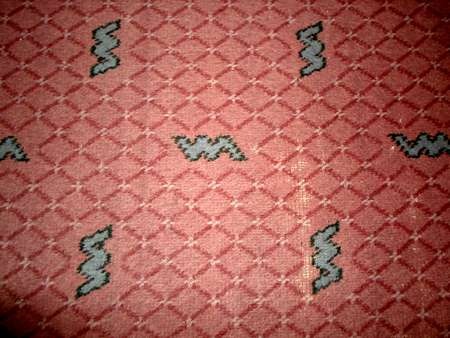
Wallace Arnold lives on in room 136 Burlington Hotel Eastbourne Feb 2016 a
little thread bear in places.
Ken Wragg
18/02/16 - 10:19
The WA’s are fairly subtle, Ken, you wouldn’t notice, if you didn’t know!
Why is it there and how did you know it was there?
Chris Hebbron
18/02/16 - 10:20
Ken, an amazing discovery in the weave of the carpet - does it actually
refer
to the coaching giant, or is it a pure coincidence??
Also, I’m sure I recall that either a
TV
documentary, or possibly a bought DVD, featured Barbara Flin in her days as a courier on some of
the
first ambitious Continental tours, to Interlaken in particular. She eventually had a major victory
against the snooty Manager of a leading hotel (still there now) in Interlaken when he
"banished" her and the driver to a quiet corner of the ballroom to eat, rather than
allowing them to dine in style with their passengers. Eventually she won and they were restored to
their rightful place in the Dining Room. I may be wrong, time dulls the memory, but I’m sure she
was
eventually the wife of Francis Flin at Croydon - can anyone confirm please, or shall I "get
mi
‘at."
Chris Youhill
18/02/16 - 11:56
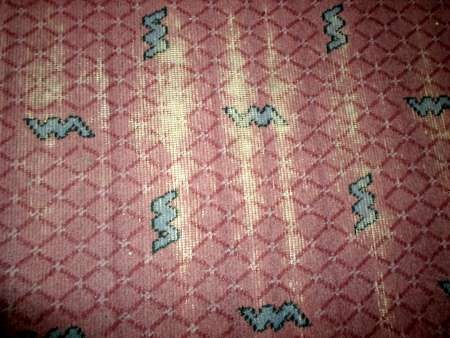
This discovery of Wallace Arnold carpet was in the room allocated during a
holiday last week at the Burlington Hotel Eastbourne (an old Wallace Arnold hotel). I was happy to
see this memento of the past but it does not show the quality I expect of the Holiday Co that owns
the hotel. I add the other photo of carpet.
Ken Wragg
19/02/16 - 05:41
Phillip, I am also eagerly awaiting volume 2 of Tom McLachlan’s book. I
understand that, although he now has health problems , the final draft was finished some years ago
and it is hoped that his son will complete the book.
Nigel Turner
19/02/16 - 05:42
Oh dear Ken - the second photo shows that it high time the carpet was
chucked
out - I hope that the rest of the hotel and in particular the cleanliness and the food were much
fresher !!
Chris Youhill
19/02/16 - 05:43
Thanks for thinking of photographing - I might offer to take it off their
hands should they ever get round to re-decorating! "Dear Manager, As a resident of Leeds you
will understand my interest in acquiring certain carpets, should they become available . . .
"
Latterly WA owned eight hotels: Pentire Hotel, Newquay; County Hotel, Llandudno; Trecarn
Hotel, Torquay; Savoy Hotel, Bournemouth; Grand Hotel, Exmouth; Broadway Park Hotel, Sandown; The
Fife Arms, Braemar; and the Burlington.
Shearings owned quite a number of hotels, more than
WA, at the time of the "merge-over"
Philip Rushworth
19/02/16 - 09:32
Philip - despite the similarity in names with Trecarne didn’t WA also own
the
Tolcarne Hotel, also I believe in Devon ??
Chris Youhill
19/02/16 - 15:26
A wonderful story, Chris, and I am sure that your identification of the
redoubtable lady who challenged the preposterous social status nonsense of a certain hotel manager
is entirely accurate. The spelling of the name ‘Flin’ is unusual, and the likelihood of there
being
another lady in the tour business with the first name of Barbara must be pretty remote. Frank Flin
died in 1962, and the Homeland agency then passed to his son, Francis John Flin, whose wife is
Barbara Mary Flin, now in her eighties. Both are still shown as directors of the business. Their
son, John Richard Flin, currently runs the firm. (“So you can leave t’ ‘at ‘anging in t’ ‘all.”
Apologies if my West Riding dialect is all wrong - my mother came from the East Riding.)
Apparently
the old close and rewarding relationship with Wallace Arnold was lost with the Shearings takeover,
to the detriment of the travel agency business, but matters did recover to some degree
subsequently.
On the subject of the Wallace Arnold depot at Spurgeon’s Bridge, Croydon, I cannot personally
recall
much about it. However, the Commercial Motor Archive tells us that around a dozen coaches were
drafted in during the summer months, though whether or not this means that the base was only used
in
summer, or that a smaller winter allocation was augmented for the season, is unclear. I would
surmise that the facilities there were pretty basic. Apparently, the depot was closed finally in
1985, whereupon Wallace Arnold then stationed some 30 vehicles at the London Buses Norwood Garage,
which was contracted to clean and refuel them. This indicates that mechanical maintenance work was
undertaken elsewhere.
Roger Cox
20/02/16 - 05:04
Mention of the Flin family in Croydon reminds me of a brief period when I
worked in their office in the winter of 1964/65. At that time I worked in the WA Traffic Office in
Leeds and volunteered to spend a week filling and addressing envelopes with tour brochures in the
Flin/WA office.
Highlights of the week included travelling down from Leeds to London on a
brown/cream Pullman (2nd class of course). For safety (being a snivelling 16 year old) my parents
insisted I stay with my aunt rather than in a dubious B&B. This was fine with me as I made the
daily
commute on red (Central Area) and green (Country Area) RTs from Tolworth to Croydon via Epsom.
Sadly, because of the time of year, most of the rides were in the dark, but I felt really grown-up
being a London commuter!
A final memory is of the kindness (and tolerance) of the Flin
family,
one of whom gave me a publicity photo of their Homeland Tours Duplex coach JVB 908 (see www.sct61.org.uk/zzjvb908)
Paul Haywood
21/02/16 - 05:56
Roger and Paul - curiosity has just made me seek out the footage with
Barbara
Flyn and her account of the stuffy Interlaken Jungfrau Hotel is as I remembered it.
It was a
Channel 4 programme called "The golden years of coach travel" or something similar, and
is
excellent throughout. The links feature Stephen Barber of WA and a fascinating Lancashire chap who
was a lifelong passenger with Yelloways of Rochdale.
Paul - I never knew of your little
adventure to Croydon - I would gladly have done the same and written a few envelopes to
"fund" it.
Chris Youhill
21/02/16 - 15:47
I recall that programme, Chris. It was "The Golden Age Of Coach
Travel". I made a DVD copy of it for a former work colleague at Peterborough, who told me
about
the no holds barred scramble to get away from Cheltenham when the "departure pistol"
went
off for all coaches to leave at the same time. Drivers who had communed jovially during the break
period then jostled mercilessly to get out and away from the queue that quickly formed at the
exit.
The programme is still available on Youtube and I’ve just watched it again. Notwithstanding a few
inconsistencies, it is a fascinating record of a time that, sadly, has totally gone.
Roger Cox
21/02/16 - 15:48
I’ve found "The Golden Age of Coach Travel" on YouTube. It is a
BBC
production of 2010. There are some wonderful anecdotes about the ‘services’ the drivers’
provided, some dubious! Here’s the link: https://www.youtube.com/watch?v=hrDQ9SNYwyc
Chris Hebbron
22/02/16 - 06:15
Does any one remember the series on TV featuring a driver called Cannonball
doing a Devon/Cornwall tour for Wallace Arnold is it still available.
Ken Wragg
22/02/16 - 09:03
‘Cannonball’ certainly appears in the above documentary, but is only
one
of several drivers saying their piece.
Chris Hebbron
23/02/16 - 05:26
Chris Y. At the time of the brochure from which I copied the hotels list
above
- mid 1990s? as there were a mix of van Hool/Jonckheere/Plaxton-bodied coaches pictured - there
was
no mention of the Tolcarne Hotel, but I’ve done a quick Google and there was a Tolcarne Hotel in
Newquay . . . "filthy and old-fashioned" according the last TripAdvisor comment in 2008.
And whilst I was about that I also Googled "Barbara Flynn" [sic], who apparently has
been
married to a Jeremy Taylor since 1982/34y-old, so the Homeland Tours connection is looking a bit
weak here! Don’t get your coat though - I’d miss your knowledgeable contributions (although I
might
take any further contributions about the performing arts with a pinch of salt!).
Philip Rushworth
23/02/16 - 10:43
Phillip, you are looking at Barbara Flynn the actress.
She played,
along
with many other parts, the Milk Lady in ‘Open All Hours’, and appeared with James Bolam in
the
Beiderbecke Trilogy. The Barbara Flin in the Golden Age of Coaching was a different lady
altogether,
and was a Courier/Guide with Wallace Arnold.
Stephen Howarth
23/02/16 - 10:46
It’s not Barbara Flynn, it’s Barbara Flin, Philip. This lady is now in her
eighties, and, with her husband Francis, is still a director of the Wallace Arnold World Wide
agency
in Croydon. (Hasn’t this discussion come a long way from a wartime Guy Arab!)
Roger Cox
13/03/16 - 14:48
I was beginning to wonder if I was on the right page here seeing as I’ve had
to wade through loads of comments nothing to do with Harper Bros. The Guy JVK 654 was bought as a
chassis and was fitted with a Lawton body, nothing in the Heath Hayes History caption says it was
a
crash box, only that it was back to front which it was. 1st & 2nd gear nearest the driver 3rd &
4th
nearest the engine. Regarding the RT’s, All the Leylands were from London and the first two AEC’s
with Craven Bodies built in Anglesey as caption states, Fleet No’s 2 & 12 KGK 729 & KGK 738.The
other seven RTA’s were from St Helens purchased 61/2.
Phil Burton
14/03/16 - 06:53
All Guy Arab I and the great majority of Arab II chassis were fitted with
the
Guy four speed sliding mesh gearbox with the ‘right to left’ upward selector positions and
the
double plate clutch inherited from the early 1934 Arab model. Arab IIs from late 1945 onwards had
the new Guy constant mesh box which had a conventional ‘left to right’ selector gate coupled
with a single plate clutch. This gearbox/clutch combination then went into the new Arab III that
was
available from late 1946.
Roger Cox
14/03/16 - 06:53
The assumption that a right-to-left gearbox would be “crash” comes from the
fact that the only gearbox Guy built to that pattern was the unit used in wartime Arabs, which was
sliding-mesh. The most likely explanation is that the Arab III acquired a gearbox from a defunct
utility double-decker later in life.
The point about the Craven bodies on the RTs is that
they
were built in Sheffield, not Anglesey. It was Saunders bodies that were built in Anglesey.
Peter Williamson
17/03/16 - 15:16
Of course you are right Peter, the Cravens bodies were built in Sheffield as
you say, I put it down to c-nile dementia, I’m getting old lol. The Guy JVK 653 was new in 1946
but
came to Harpers as just a chassis in 1954 and a Lawton body was fitted. The gear knob was maroon
and
of a mushroom shape rather than a ball
Phil Burton
28/03/16 - 11:38
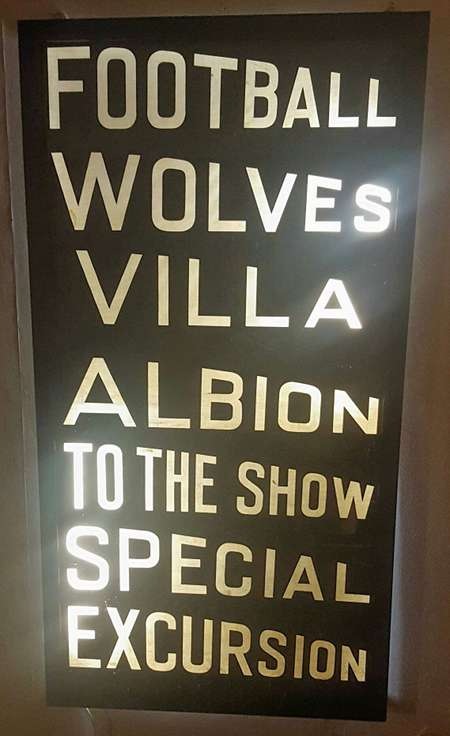
I’m an lifelong Villa fan and have just been given a very old bus blind
(shown
here framed and back lit) by a mate of mine here in New Zealand - he brings in vintage stuff from
the UK to sell on in this part of the world - the cloth blind has a sloping font and 7
destinations
‘FOOTBALL’ ‘WOLVES’ ‘VILLA’ ‘ALBION’ ‘TO THE SHOW’ ‘SPECIAL’
and
‘EXCURSION’. He knew, because of the sloping font, that it came off a 40’s / 50’s bus and
after hunting around the internet my guess, after reading this page and in particular the post on
12/06/12 by Phil Burton, is that it came of a Harper Bros bus. Looking at the images I can find my
guess is that it came off a/the Guy Arab III with Lawton bodywork.
George Shaw
 Vehicle reminder shot for this posting
Vehicle reminder shot for this posting
10/04/16 - 05:24
Homeland Tours owned a booking office in Park Lane Croydon, on the corner of
Park Street in the 1950s. Their fleet of Leyland coaches were kept at the Regal Garage in the Old
Kent Road. The owners of the Regal Garage sold it to new owners in 1955, and Homeland Tours were
asked to vacate the premises. The Homeland Tours fleet was sold to Bourne and Balmer of Croydon, a
subsidiary company of Timpsons since 1953. The two Homeland Tours Leyland Tiger Cubs with
underfloor
engines MBY 909, MBY 910,were kept by Bourne and Balmer, but the normal control Leyland Comets
were
sold to dealers. Homeland Tours became an agent for Wallace Arnold, and the Park Lane office
traded
under the Wallace Arnold name. The building was sold some years later, and they moved around the
corner to George Street. At least one of the Leyland Comets went to work for Chiltern Queens in
Oxford.
H. Daulby
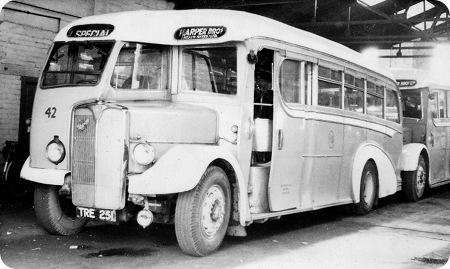
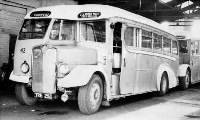 Vehicle reminder shot for this posting
Vehicle reminder shot for this posting
